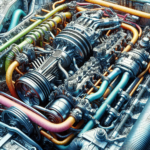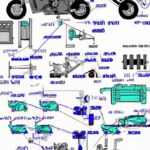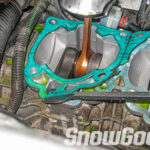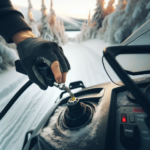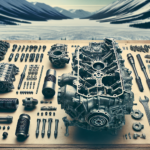Picture yourself bundled up, gliding through a beautiful, snowy landscape on your trusty snowmobile. Have you ever wondered how this amazing machine keeps going, even under harsh winter conditions? A crucial part of this system is the fuel pump – a intricately designed part that plays a vital role in ensuring your snowmobile’s engine runs smoothly. This piece paints a clear picture of how a fuel pump in a snowmobile works, what it does, and why it’s so important to your vehicle’s overall performance. You’ll gain an understanding of the inner mechanics that power your winter rides and what to keep an eye on to ensure they stay in tip-top shape.
Understanding the Role of a Fuel Pump
You can’t underestimate the role of a fuel pump in various engine-driven machines, especially in snowmobiles. These small, unassuming parts play an essential function in the smooth operation of a snowmobile, ensuring you enjoy every bit of your ride in the snow.
Basic Function of a Fuel Pump
To understand its significant role, let’s first talk about what a fuel pump does. Essentially, a fuel pump in your snowmobile takes the fuel—usually gasoline—from the tank and delivers it to the engine’s combustion chambers. This process ensures that your snowmobile’s engine receives the right amount of fuel to mix with air and ignite for power production efficiently.
Significance of Fuel Pump in a Snowmobile
If the fuel pump is not working properly, your snowmobile could suffer from reduced horsepower and efficiency, leading to a lackluster performance. It goes without saying; a defective fuel pump could put a damper on your snowy escapade. Therefore, understanding your snowmobile’s fuel pump is not just essential for maintaining its performance but also ensuring a safe and enjoyable ride.
Types of Fuel Pumps in Snowmobiles
Now that you understand the basics, let’s delve deeper into the types of fuel pumps commonly found in snowmobiles.
Mechanical Fuel Pumps
In simple terms, a mechanical fuel pump relies on mechanical movement to pump fuel. These types of pumps often use the engine’s camshaft or crankshaft motion to function, making them an integral part of the engine assembly. Mechanical fuel pumps are more common in older model snowmobiles but are still used today in some configurations.
Electric Fuel Pumps
On the other hand, electric fuel pumps rely on electrical power for operation. These pumps are usually powered by your snowmobile’s battery and use a motor to pump fuel. Electric fuel pumps offer several advantages such as improved fuel efficiency and precise fuel delivery, making them the more popular choice in modern snowmobiles.
How a Mechanical Fuel Pump Works
Let’s break down how a mechanical fuel pump operates.
Understanding the Principle of a Mechanical Pump
Like its name suggests, a mechanical pump uses mechanical energy to pump fuel. That’s why it is typically located near the engine, drawing its operating power from the engine’s motion—specifically, the motion of the camshaft or crankshaft.
Components of a Mechanical Fuel Pump
The basic components of a mechanical fuel pump include the diaphragm, lever arm, springs, and pull rod. The diaphragm divides the pump into the fuel chamber and the air chamber, while the lever arm interacts with the engine component to drive the diaphragm.
Operation of a Mechanical Fuel Pump
In operation, as the engine turns, the lever arm moves up and down, creating a suction force on the diaphragm. This movement sucks in the fuel from the tank. Next, the spring-loaded pull rod forces the diaphragm back down, pushing out the fuel to the engine carburetor. This process repeats, providing a continuous fuel supply for engine operation.
How an Electric Fuel Pump Works
Now, let’s understand the working principle of the electric fuel pump.
Principle behind an Electric Fuel Pump
An electric fuel pump operates on the principle of electromagnetic induction. The pump uses an electric motor that spins a pump impeller, which helps to draw fuel from the tank and pump it to the engine.
Components of an Electric Fuel Pump
The major components of an electric fuel pump include an electric motor, pump impeller, inlet and outlet valves, and a relay switch. The relay switch provides the power needed to operate the motor.
Operation of an Electric Fuel Pump
When activated, the motor spins the impeller, creating a vacuum that draws the fuel into the pump. The fuel is then pushed out through the outlet valve and sent to the fuel injection system. The relay switch controls the operation of the pump, ensuring it only works when it’s necessary—in simple words, when your snowmobile’s engine is running.
Fuel Pump Placement and Installation
The place where the fuel pump is installed can differ based on the type of pump and the snowmobile model.
Location of Fuel Pump in a Snowmobile
In snowmobiles utilizing a mechanical fuel pump, you’ll often find the pump installed close to the engine, as it relies on its motion for operation. Conversely, an electric fuel pump might be installed anywhere between the fuel tank and the engine—often it’s submerged inside the fuel tank itself.
Key Considerations during Installation
When installing a fuel pump, whether mechanical or electric, there are certain key considerations. The fuel pump should be secured firmly to avoid loosening due to vibrations. Moreover, all connections including the fuel lines and electrical connections (for an electric pump) should be secured and checked for leaks.
Signs of a Malfunctioning Fuel Pump
Like any other machine part, fuel pumps may experience wear and tear, leading to their malfunctioning. It’s crucial to recognize the early signs of a failing fuel pump for timely intervention.
Common Symptoms of a Failing Fuel Pump
The common signs of a malfunctioning fuel pump include reduced engine performance, higher fuel consumption, difficulty in starting the engine, and even the engine stalling frequently during rides. If your snowmobile is sputtering or losing power while accelerating, these might be signs of a failing fuel pump.
Diagnosing Issues in the Fuel Pump
If you notice any of above symptoms, it’s time to inspect the fuel pump. You can visually inspect the pump for any leaks, check fuel pressure, and even use fuel pump testing tools for diagnosis.
Troubleshooting Common Fuel Pump Issues
So, your fuel pump is failing, what next? Here are some troubleshooting steps and maintenance tips to ensure your fuel pump remains in top shape.
Regular Checks and Maintenance
Regularly checking your fuel pump for any leaks or signs of wear and tear can prevent severe problems later on. It’s also a good practice to clean the fuel pump regularly to ensure its operational efficiency.
Steps to Rectify Common Problems
If you notice a problem with your fuel pump, first verify whether it’s a fuel pump issue. Check the connections and the fuel lines, and ensure that the fuel tank contains enough fuel. Replacing a worn-out pump lever or diaphragm in a mechanical pump or checking the relay switch in an electric pump can solve the problem in some cases.
When to Seek Professional Assistance
If none of the above troubleshooting steps work, or you are not comfortable diagnosing and repairing the fuel pump yourself, it’s time to seek professional help. Remember, it’s better to let a professional handle things than risk causing more – potentially expensive – damage yourself.
Replacing a Fuel Pump on a Snowmobile
Sometimes, despite best efforts, it might be necessary to replace your snowmobile’s fuel pump. Let’s see when and how to do this.
When to Decide on Replacing a Fuel Pump
If your fuel pump is frequently failing despite repairs, it might be time to consider replacement. An overly worn pump or a pump that’s been operated for many years could be an ideal candidate for replacement.
Steps to Replace a Fuel Pump
The basic steps to replace a fuel pump include purchasing a suitable replacement pump, disconnecting the fuel lines, removing the old pump, installing the new pump, and thoroughly testing it to ensure proper functioning.
Precautions While Replacing a Fuel Pump
Safety is of utmost importance when replacing a fuel pump. Use appropriate safety gear, ensure your work area is well ventilated and devoid of any open flames or sparks. Additionally, be sure to relieve the fuel pressure before starting the replacement, and remember to dispose of the old pump safely.
Understanding the Importance of Fuel Regulations
Fuel regulations are crucial to the operation of your fuel pump and overall performance of your snowmobile.
Correct Fuel Pressure and Flow Rate for Optimal Functioning
The fuel pump must maintain a specific pressure and flow rate to function optimally, hence it is important to know and observe these specifications. A pump that doesn’t produce the right fuel pressure can affect your snowmobile engine’s performance and fuel efficiency.
How Fuel Regulations Affect the Fuel Pump Performance
Regulations on fuel specifications such as its type, quality, and blend can directly impact the efficiency of your fuel pump. Using the wrong type of fuel, that your pump is not designed to handle can lead to premature wear, causing your fuel pump to fail prematurely.
Latest Technology and Innovations in Fuel Pumps
Like every other aspect of technology, fuel pumps are evolving too. Let’s take a peek at what the future holds.
New Advancements in Fuel Pump Technology
In recent years, there have been advancements such as variable speed fuel pumps, smart fuel pumps equipped with self-diagnostic functionality, and even fuel pumps made from innovative materials for higher durability.
How Innovations Improve Fuel Pump Efficiency and Performance
These innovations aren’t just fancy add-ons; they significantly improve the fuel pump’s performance and efficiency. For instance, variable-speed pumps can adjust their speed based on engine demand, leading to better fuel efficiency. Similarly, self-diagnostic features make it easier to identify and troubleshoot fuel pump issues.
There you have it! You’re now more familiar with the workings of a snowmobile’s fuel pump. Remember, a well-maintained fuel pump equals a well-performing snowmobile. So, the next time you’re out on the snow, give a little nod to the powerful little fuel pump beneath you, quietly doing its job.
- What Snowboard Bindings Should I Get? - January 23, 2024
- What Size Screws For Snowboard Bindings? - January 23, 2024
- How To Snowmobile On Water? - January 23, 2024

